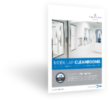
New Catalog
Download our Cleanroom Catalog
DownloadFive Facts to Know about Modular Cleanrooms
The time when the modular cleanroom was more expensive than stick-built is long gone. Nowadays, cleanroom manufacturers use specialized tools, have optimized their production processes, have less down time, benefit from a specialized workforce and can count on cheaper labor costs than those on construction sites (due to Union rates, travel expenses, etc.).
You shouldn’t take for granted that every cleanroom manufacturers’ modular panels are the same. Although some cleanroom manufacturers claim their panels are fully prefabricated, this is not always true. Certain manufacturers pre-engineer and prefabricate every panel, which means access and control panels are pre-engineered, window openings are pre-cut, panels already have the proper dimensions, etc. But others use standard panels and must cut them to be fitted once on-site, which creates a certain amount of dust and noise, and requires additional installation time. Certain manufacturers supply panels with pre-fitted wiring and fixtures, whereas others don’t. Be sure to ask your cleanroom manufacturer what to expect beforehand since it may be less of a clean installation than you might be anticipating.
Air returns are necessary to recirculate the air from within the cleanroom to the HVAC system. Some manufacturers use built-in air return chases within the panels, as shown in the picture. In this case, a plenum is created inside the wall panel to form an air return cavity. Other cleanroom manufacturers add a duct behind the panel, which takes up additional space. In traditional construction, a wall is often simply doubled to create the air return cavity in between the walls. The two latter options do not optimize the building footprint, which is unfortunate since available space is often limited.
Modular cleanrooms are often considered as production equipment compared to traditional stick-built cleanrooms, which are considered building or leasehold improvement. Therefore, they often qualify for accelerated depreciation. Hence, there are tax advantages associated with modular cleanroom construction. Consult with your accountants and tax advisors to determine the appropriate tax classification that applies to your specific situation. Moreover, modular cleanrooms are a true asset that you can rent, sell, relocate or modify easily.
What is your growth plan? Future reconfigurations or expansions can and should be taken into account in the design of your cleanroom facility. In comparison with stick-built, modular cleanrooms are flexible and adaptable, and make reconfiguration easy. If you plan on adding partitions or enlarging the room in the future, this can be engineered in the design phase by either installing reinforcements in the panels or integrating easily removable “door size” panels. Even if future modifications have not been engineered in the cleanroom design, it is always possible to add extra sections to a modular cleanroom. Modular cleanrooms can also be moved to another location.
Learn everything about the clean room classifications.
By continuing to use the site you agree to our privacy policy.
I agree